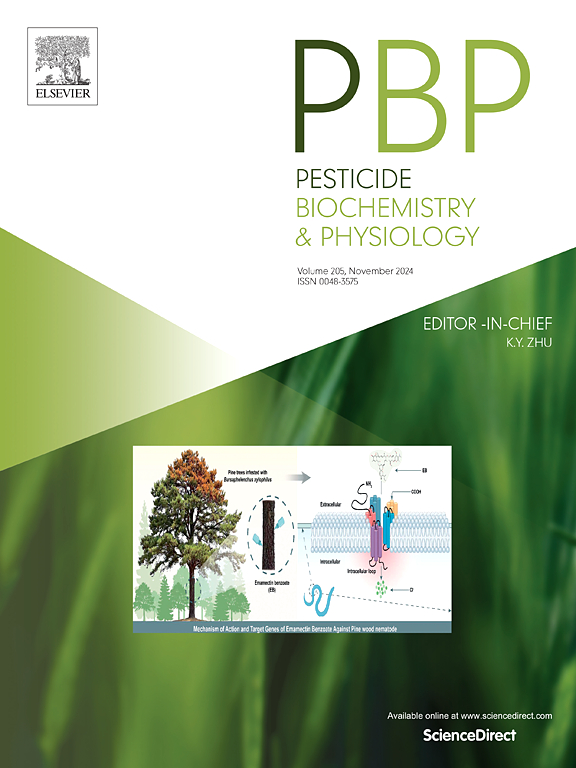废烟叶多糖及其抗tmv活性研究
IF 4.2
1区 农林科学
Q2 BIOCHEMISTRY & MOLECULAR BIOLOGY
引用次数: 0
摘要
天然多糖因其抗病毒作用在生物农药中受到越来越多的关注。烟叶中含有丰富的多糖,具有抗烟草花叶病毒(TMV)的潜力,但残烟叶多糖(DTCP)的化学结构和抗花叶病毒的作用尚不清楚。在提取时间3.5 h、温度90℃、料液比1:45的条件下,DTCP的最大提取率为21.11%。随后,通过DEAE和Sephadex G-100柱从DTCP中纯化出3061 Da的均相多糖(DTP)。DTP的主要单糖组成是葡萄糖(Glc)、葡萄糖醛酸(GlcA)、半乳糖(Gal)和半乳糖醛酸(GalA),摩尔比为3.9:2.6:1.06:0.84。核磁共振、甲基化和红外光谱分析表明,DTP是一种以→4)-β- d - galp -(1→4)-β- d - galp -(1→4)-β- d - glcp为主链的多糖,其支点由α-D-Glcp-(1→)、α-D-GlcpA-(1→)和α-D-GalpA-(1→)组成。在500 μg/mL浓度下,百白破对TMV的抑制率分别为80.40%和76.18%。DTP还干扰了TMV-CP的聚合,限制了其自组装。此外,DTP能使烟草超氧化物歧化酶、过氧化氢酶、过氧化物酶和苯丙氨酸解氨酶活性分别提高1.83倍、2.73倍、3.69倍和4.84倍,并能减轻烟草的超敏反应和全身获得性抗性。因此,百白破可作为一种新的植物源性农药用于防治农业上的TMV。本文章由计算机程序翻译,如有差异,请以英文原文为准。

Polysaccharide from discarded tobacco leaves and its anti-TMV activities
Natural polysaccharides have been attracted increasing attention in biopesticides for the antiviral effects. Tobacco leaves enriched the polysaccharides and had the potential against tobacco mosaic virus (TMV), however, the chemical structure and anti-TMV effect of polysaccharides from discarded tobacco leaves (DTCP) are still unclear. In this study, an optimized condition for extraction time of 3.5 h, temperature of 90 °C, and solid-liquid ratio of 1:45 led to the maximum extraction value of 21.11 % for DTCP. Subsequently, a homogeneous polysaccharide (DTP) of 3061 Da was purified from DTCP by DEAE and Sephadex G-100 column. The major monosaccharide composition of DTP was glucose (Glc), glucuronic acid (GlcA), galactose (Gal), and galacturonic acid (GalA) in a molar ratio of 3.9:2.6:1.06:0.84. NMR, methylation and IR analysis showed that DTP was a polysaccharide with →4)-β-D-Galp-(1 → 4)-β-D-Galp-(1 → 4)-β-D-Glcp as the main chain, and its branching points were composed of α-D-Glcp-(1→, α-D-GlcpA-(1→ and α-D-GalpA-(1→. Furthermore, DTP exhibited significant inactive and protective effects against TMV with the inhibitory rates of 80.40 % and 76.18 % at 500 μg/mL, respectively. DTP also interfered with the polymerization of TMV-CP to limit its self-assembly. Additionally, DTP could increase the superoxide dismutase, catalase, peroxidase and phenylalanine ammonia lyase activities of tobacco plants by 1.83, 2.73, 3.69 and 4.84 times, respectively, and could alleviate the hypersensitive response and systemic acquired resistance. Hence, DTP could serve as a new plant-derived pesticide for controlling TMV in agriculture.
求助全文
通过发布文献求助,成功后即可免费获取论文全文。
去求助
来源期刊
CiteScore
7.00
自引率
8.50%
发文量
238
审稿时长
4.2 months
期刊介绍:
Pesticide Biochemistry and Physiology publishes original scientific articles pertaining to the mode of action of plant protection agents such as insecticides, fungicides, herbicides, and similar compounds, including nonlethal pest control agents, biosynthesis of pheromones, hormones, and plant resistance agents. Manuscripts may include a biochemical, physiological, or molecular study for an understanding of comparative toxicology or selective toxicity of both target and nontarget organisms. Particular interest will be given to studies on the molecular biology of pest control, toxicology, and pesticide resistance.
Research Areas Emphasized Include the Biochemistry and Physiology of:
• Comparative toxicity
• Mode of action
• Pathophysiology
• Plant growth regulators
• Resistance
• Other effects of pesticides on both parasites and hosts.

 求助内容:
求助内容: 应助结果提醒方式:
应助结果提醒方式:


